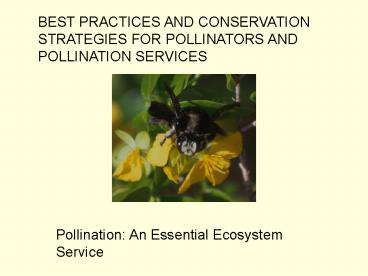Pollination: An Essential Ecosystem Service - PowerPoint PPT Presentation
1 / 14
Title:
Pollination: An Essential Ecosystem Service
Description:
An estimated one out of every three bites of food we eat comes ... Worldwide, of the estimated 1,330 crop plants grown for food, ... Dioecious papaya ... – PowerPoint PPT presentation
Number of Views:59
Avg rating:3.0/5.0
Title: Pollination: An Essential Ecosystem Service
1
BEST PRACTICES AND CONSERVATION STRATEGIES FOR
POLLINATORS AND POLLINATION SERVICES
Pollination An Essential Ecosystem Service
2
An estimated one out of every three bites of
food we eat comes from a pollinator.
In the U.S., pollination by insects produces
40 billion worth of products annually.
Worldwide, of the estimated 1,330 crop
plants grown for food, beverages, fibers,spices,
and medicines, approximately 75 are pollinated
by animals.
3
Overlay of Agricultural Lands and Protected Areas
4
Keeping productivity high on existing
land
Ochieng Gemmill study in Nguruman, Kenya
5
- Buzz Pollination in the Solanaceae
6
Alternative Pollinator Resources in Adjacent
Habitat
Largest components of total cover in the
herbaceous layer of the three wild habitat types
adjacent to farmland
open pathside (OP) thick (riverine) Acacia
forest (TA) grassy sward (GS) Commicarpus
helenae (28.3) Vigna vexillata (34.5)
Cynodondactylon (56.7) bare ground
(16.8) Abutilon hirsutum (29.3) bare
ground (16.3) Justicia flava (9.3) Acryanthes
aspera (13.8) Leucas massaiensis
(7.7) Barleria eranthemoides (9.2) Grewis
bicolor (9.7) Ruellia patula
(7.0) Hibiscus palmatus (4.5) bare ground
(4.0) Bothriocline tomentosa (3.0)
3
2
1
7
(No Transcript)
8
(No Transcript)
9
Riverine Acacia woodland of Nguruman
10
Habitat Needs of Wild Pollinator
Species Nesting sites undisturbed
areas Protective cover diverse perennial
cover Adequate, clean water few pollutants,
source flow/recharge, water access Access to
territory functional corridors All-season food
access diverse food sources Predator-prey
balance diversity, protection Interdependent
species patches of natural vegetation, avoid
unnecessary disturbance
11
To promote the conservation of pollinators, we
should
12
Hawkmoths (Sphingidae) are pollinators of Papaya
Dioecious papaya requires pollinators. Fruit set
and quality is related to pollination services
provided
13
(No Transcript)
14
For more information, please contact
The African Pollinator Initiative Secretariat C/o
Environment Liaison Centre International P. O.
Box 72461, Nairobi 00200 Kenya Email
dinom_at_elci.org































